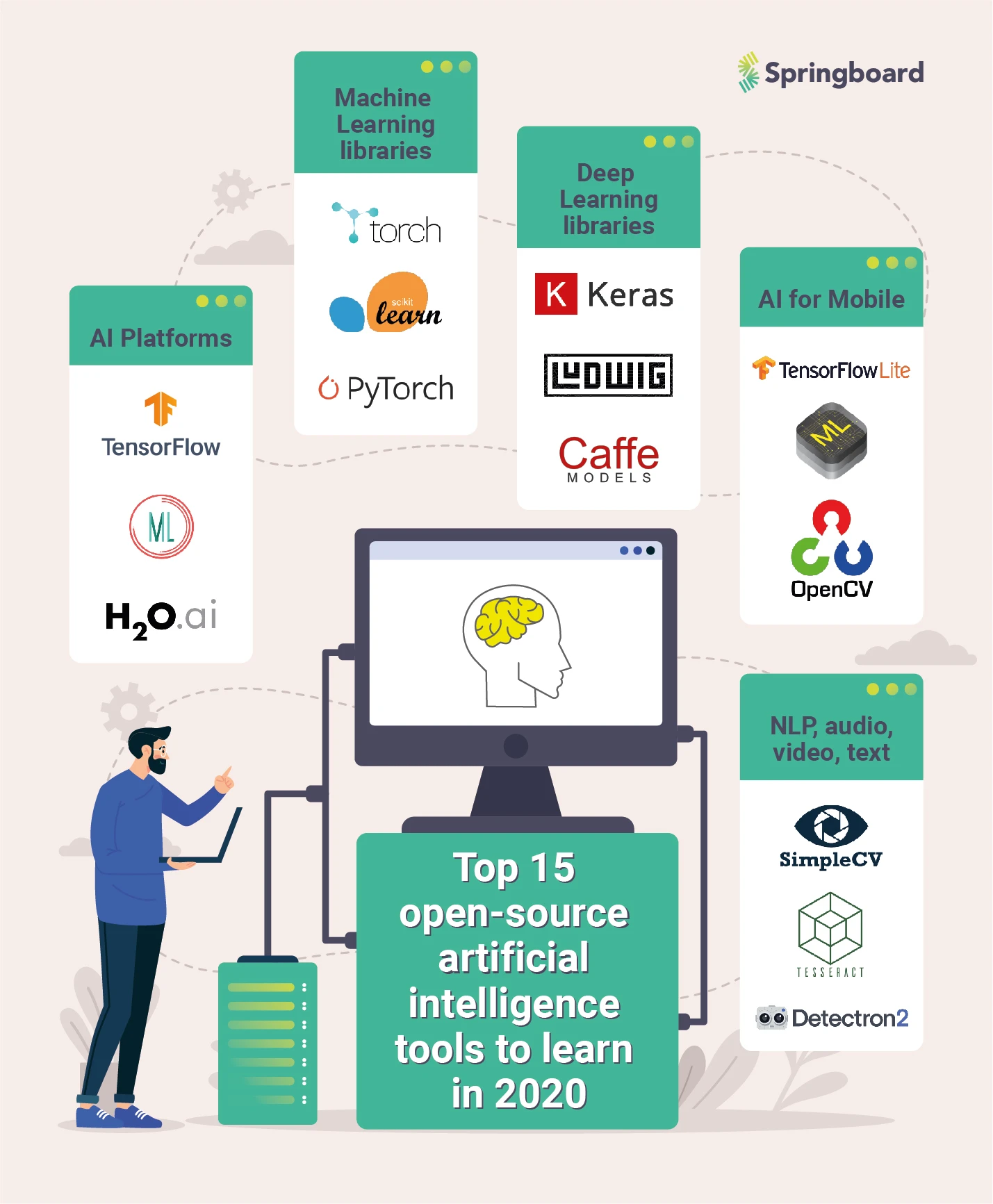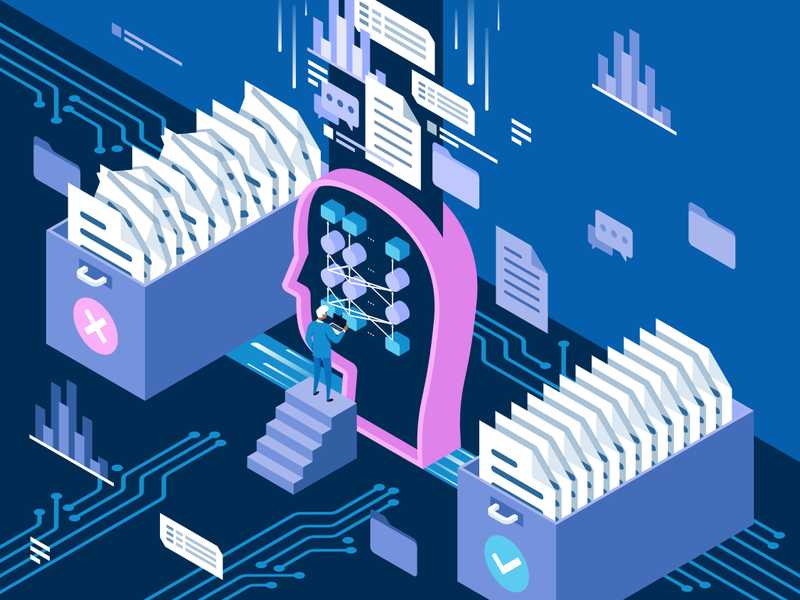Today, Artificial Intelligence (AI) is routinely performing tasks both mundane and miraculous. From the smart filters that keep pesky spam from clogging your email to the facial recognition system that reunited thousands of lost children with their parents in India, artificial intelligence tools and methods are changing life as we know it. And this is just the beginning.
In theory, artificial intelligence is machines that think and act like humans, by mimicking our intelligence and cognition. In practice, this is a lot more complex: It involves hundreds of thousands of processes of feeding machines with data and logic to ‘teach’ them intelligence. For the uninitiated, this can seem daunting.
It doesn’t have to be! The trailblazers of AI have established a concrete foundation of tools, frameworks, libraries, and documentation to help young professionals like you find your place. Engineers from Google, Facebook, Uber, and other large companies have open-sourced battle-tested artificial intelligence tools and made them available to you, online and for free.
Here are the Top 15 Open-Source Artificial Intelligence Tools to Learn

1. Artificial Intelligence Tools: AI Platforms
Think of an AI platform as your personal tool shed, where you stack a wide range of tools you use to design algorithms, build intelligent applications, or even business solutions. Platforms typically have multiple functionalities — say, a graphical user interface (GUI), existing libraries, pre-built workflows, integrated development environments (IDE), etc. Here are the top three AI platforms you must learn in 2022.
- TensorFlow, developed by Google, is the most popular platform today for building and deploying machine learning models. You can get started using TensorFlow if you have moderate familiarity with Python or C++. If you’re having teething troubles, no worries, the platform has a wide range of tools, libraries and a vibrant community of technologists to help every need.
- Apache SystemML, originally developed by IBM, is a flexible, scalable platform to deploy machine learning algorithms for big data. It accelerates algorithm deployment with their high-level programming language called declarative machine learning (DML), which R programmers will find familiar; and a variant called PyDML for Python developers. It automatically optimizes usage based on data and cluster characteristics to improve efficiency. It scales to both Hadoop and Spark clusters.
- H2O.ai is an enterprise-grade AI platform for deploying machine learning, deep learning and gradient boosting algorithms. It supports popular languages like Python, R, and Java and is used in over 18,000 organizations globally.
Get To Know Other Data Science Students
Joy Opsvig
Data Science Apprentice Engineer at LinkedIn
Esme Gaisford
Senior Quantitative Data Analyst at Pandora
Sam Fisher
Data Science Engineer at Stratyfy
Machine Learning Libraries
A machine learning library is a set of functions, pre-written and reusable, for similar purposes. That are typically written in specific programming languages like Python or R. The fundamental advantage of a library is that it saves developers the time and energy involved in manually writing code for each task. Several AI platforms — such as TensorFlow — come pre-built with their own set of libraries. Here are a few additional ones.
- Scikit-learn is a well known ML library, based on Python. It provides a range of unsupervised and supervised algorithms — classification, regression, random forests, gradient boosting, etc. — on an interface. The popular music app Spotify uses scikit-learn libraries for training models to create playlists.
- Torch is a widely used ML library, based on Lua, an easy and fast language. It is widely used in applications where speed and parallel processing are essential. Twitter’s algorithm switch to top tweets from reverse chronological tweets was powered by Torch.
- PyTorch is an ML library based on Torch. First developed by Facebook, PyTorch is simple to use, shortening the learning curve for developers and reducing time to deployment. In fact, a study from last year found that PyTorch is the tool of choice for researchers working on machine learning problems since it combines simplicity, performance, and a better-designed API.
Deep Learning Tools
Deep Learning, a subset of AI, is based on artificial neural networks or connectionist systems. It has seen a wide range of uses across industries in speech recognition, image recognition, recommendation engines, etc. A deep learning tool is one that makes the building and deployment of deep learning applications easier, faster or more efficient. Some of the more popular ones are here.
7. Keras is a deep learning library written in Python. It is designed for fast experimentation on deep neural networks, processing data through sophisticated mathematical models. Everyone’s favorite streaming service Netflix, uses Keras for its recommendation engine.
8. Uber Ludwig is the deep learning library developed on TensorFlow, by Uber. It is used to train, test and deploy machine learning models — no coding required! Non-programmers turn to Ludwig to develop models fast and without errors. Uber employs Ludwig in a variety of ways — to improve maps, streamline communication and even predict when an Uber Eats order will be delivered.
9. Caffe, developed by UC Berkeley, is a deep learning library built for speed — it can process more than 60 million images daily! It is predominantly deployed for image processing applications that require higher computing power and model accuracy.
Tools for Building AI on Mobile
While most of the above tools can also be used to deploy machine learning algorithms for mobile applications, sometimes they might not be enough. For those cases, here are some mobile-friendly artificial intelligence tools.
10. TensorFlow Lite is TensorFlow’s version for on-device inference to deploy ML models on mobiles and single-board computers. You can pick a new or existing model, convert it, and download and deploy it for mobile. For instance, you can build Snapchat or Instagram-like filters using TensorFlow Lite.
11. Apple Core ML, as the name suggests, is a framework to build machine learning and deep learning models for the iOS ecosystem. The latest edition, Core ML 3 is the force behind iPhone features such as FaceID and animoji.
12. OpenCV, developed originally by Intel, is a machine learning library for real-time computer vision applications. Several face detection apps on smartphones are powered by OpenCV.
Natural Language Processing Tools
NLP is an area under AI that processes humans’ natural speech, text, and video to gain intelligence. NLP tools tend to specialize in artificial intelligence tools, adept at performing functions such as speech recognition, computer vision, object detection, etc. Here are some of the top ones.
13. SimpleCV is an easy to use machine learning library to build computer vision applications. It is popular with beginners who want to engage in quick prototyping and simple applications, as it does not require knowledge of file formats, buffer management, etc.
14. Tesseract is Google’s optical character recognition (OCR) engine which converts handwritten or typed data into a format that is recognizable and editable by machines. Cited as the most accurate of all the OCR engines, Tesseract supports multiple languages.
15. Detectron is an object detection algorithm. Developed by Facebook, based on Caffe2 and written in Python, Detectron is commonly used to train models for their augmented reality applications.
While our mentors and teachers have scoured the web to bring the best 15 artificial intelligence tools for your use, we must acknowledge that this is just the tip of the iceberg. There is an unlimited number of artificial intelligence examples, hundreds of tools to implement them, and we expect hundreds more in the making. The world of AI can be a bit overwhelming like that.
For further reading, find out what data scientist does and learn more about data science.
Companies are no longer just collecting data. They’re seeking to use it to outpace competitors, especially with the rise of AI and advanced analytics techniques. Between organizations and these techniques are the data scientists – the experts who crunch numbers and translate them into actionable strategies. The future, it seems, belongs to those who can decipher the story hidden within the data, making the role of data scientists more important than ever.
In this article, we’ll look at 13 careers in data science, analyzing the roles and responsibilities and how to land that specific job in the best way. Whether you’re more drawn out to the creative side or interested in the strategy planning part of data architecture, there’s a niche for you.
Is Data Science A Good Career?
Yes. Besides being a field that comes with competitive salaries, the demand for data scientists continues to increase as they have an enormous impact on their organizations. It’s an interdisciplinary field that keeps the work varied and interesting.
10 Data Science Careers To Consider
Whether you want to change careers or land your first job in the field, here are 13 of the most lucrative data science careers to consider.
Data Scientist
Data scientists represent the foundation of the data science department. At the core of their role is the ability to analyze and interpret complex digital data, such as usage statistics, sales figures, logistics, or market research – all depending on the field they operate in.
They combine their computer science, statistics, and mathematics expertise to process and model data, then interpret the outcomes to create actionable plans for companies.
General Requirements
A data scientist’s career starts with a solid mathematical foundation, whether it’s interpreting the results of an A/B test or optimizing a marketing campaign. Data scientists should have programming expertise (primarily in Python and R) and strong data manipulation skills.
Although a university degree is not always required beyond their on-the-job experience, data scientists need a bunch of data science courses and certifications that demonstrate their expertise and willingness to learn.
Average Salary
The average salary of a data scientist in the US is $156,363 per year.
Data Analyst
A data analyst explores the nitty-gritty of data to uncover patterns, trends, and insights that are not always immediately apparent. They collect, process, and perform statistical analysis on large datasets and translate numbers and data to inform business decisions.
A typical day in their life can involve using tools like Excel or SQL and more advanced reporting tools like Power BI or Tableau to create dashboards and reports or visualize data for stakeholders. With that in mind, they have a unique skill set that allows them to act as a bridge between an organization’s technical and business sides.
General Requirements
To become a data analyst, you should have basic programming skills and proficiency in several data analysis tools. A lot of data analysts turn to specialized courses or data science bootcamps to acquire these skills.
For example, Coursera offers courses like Google’s Data Analytics Professional Certificate or IBM’s Data Analyst Professional Certificate, which are well-regarded in the industry. A bachelor’s degree in fields like computer science, statistics, or economics is standard, but many data analysts also come from diverse backgrounds like business, finance, or even social sciences.
Average Salary
The average base salary of a data analyst is $76,892 per year.
Business Analyst
Business analysts often have an essential role in an organization, driving change and improvement. That’s because their main role is to understand business challenges and needs and translate them into solutions through data analysis, process improvement, or resource allocation.
A typical day as a business analyst involves conducting market analysis, assessing business processes, or developing strategies to address areas of improvement. They use a variety of tools and methodologies, like SWOT analysis, to evaluate business models and their integration with technology.
General Requirements
Business analysts often have related degrees, such as BAs in Business Administration, Computer Science, or IT. Some roles might require or favor a master’s degree, especially in more complex industries or corporate environments.
Employers also value a business analyst’s knowledge of project management principles like Agile or Scrum and the ability to think critically and make well-informed decisions.
Average Salary
A business analyst can earn an average of $84,435 per year.
Database Administrator
The role of a database administrator is multifaceted. Their responsibilities include managing an organization’s database servers and application tools.
A DBA manages, backs up, and secures the data, making sure the database is available to all the necessary users and is performing correctly. They are also responsible for setting up user accounts and regulating access to the database. DBAs need to stay updated with the latest trends in database management and seek ways to improve database performance and capacity. As such, they collaborate closely with IT and database programmers.
General Requirements
Becoming a database administrator typically requires a solid educational foundation, such as a BA degree in data science-related fields. Nonetheless, it’s not all about the degree because real-world skills matter a lot. Aspiring database administrators should learn database languages, with SQL being the key player. They should also get their hands dirty with popular database systems like Oracle and Microsoft SQL Server.
Average Salary
Database administrators earn an average salary of $77,391 annually.
Data Engineer
Successful data engineers construct and maintain the infrastructure that allows the data to flow seamlessly. Besides understanding data ecosystems on the day-to-day, they build and oversee the pipelines that gather data from various sources so as to make data more accessible for those who need to analyze it (e.g., data analysts).
General Requirements
Data engineering is a role that demands not just technical expertise in tools like SQL, Python, and Hadoop but also a creative problem-solving approach to tackle the complex challenges of managing massive amounts of data efficiently.
Usually, employers look for credentials like university degrees or advanced data science courses and bootcamps.
Average Salary
Data engineers earn a whooping average salary of $125,180 per year.
Database Architect
A database architect’s main responsibility involves designing the entire blueprint of a data management system, much like an architect who sketches the plan for a building. They lay down the groundwork for an efficient and scalable data infrastructure.
Their day-to-day work is a fascinating mix of big-picture thinking and intricate detail management. They decide how to store, consume, integrate, and manage data by different business systems.
General Requirements
If you’re aiming to excel as a database architect but don’t necessarily want to pursue a degree, you could start honing your technical skills. Become proficient in database systems like MySQL or Oracle, and learn data modeling tools like ERwin. Don’t forget programming languages – SQL, Python, or Java.
If you want to take it one step further, pursue a credential like the Certified Data Management Professional (CDMP) or the Data Science Bootcamp by Springboard.
Average Salary
Data architecture is a very lucrative career. A database architect can earn an average of $165,383 per year.
Machine Learning Engineer
A machine learning engineer experiments with various machine learning models and algorithms, fine-tuning them for specific tasks like image recognition, natural language processing, or predictive analytics. Machine learning engineers also collaborate closely with data scientists and analysts to understand the requirements and limitations of data and translate these insights into solutions.
General Requirements
As a rule of thumb, machine learning engineers must be proficient in programming languages like Python or Java, and be familiar with machine learning frameworks like TensorFlow or PyTorch. To successfully pursue this career, you can either choose to undergo a degree or enroll in courses and follow a self-study approach.
Average Salary
Depending heavily on the company’s size, machine learning engineers can earn between $125K and $187K per year, one of the highest-paying AI careers.
Quantitative Analyst
Qualitative analysts are essential for financial institutions, where they apply mathematical and statistical methods to analyze financial markets and assess risks. They are the brains behind complex models that predict market trends, evaluate investment strategies, and assist in making informed financial decisions.
They often deal with derivatives pricing, algorithmic trading, and risk management strategies, requiring a deep understanding of both finance and mathematics.
General Requirements
This data science role demands strong analytical skills, proficiency in mathematics and statistics, and a good grasp of financial theory. It always helps if you come from a finance-related background.
Average Salary
A quantitative analyst earns an average of $173,307 per year.
Data Mining Specialist
A data mining specialist uses their statistics and machine learning expertise to reveal patterns and insights that can solve problems. They swift through huge amounts of data, applying algorithms and data mining techniques to identify correlations and anomalies. In addition to these, data mining specialists are also essential for organizations to predict future trends and behaviors.
General Requirements
If you want to land a career in data mining, you should possess a degree or have a solid background in computer science, statistics, or a related field.
Average Salary
Data mining specialists earn $109,023 per year.
Data Visualisation Engineer
Data visualisation engineers specialize in transforming data into visually appealing graphical representations, much like a data storyteller. A big part of their day involves working with data analysts and business teams to understand the data’s context.
General Requirements
Data visualization engineers need a strong foundation in data analysis and be proficient in programming languages often used in data visualization, such as JavaScript, Python, or R. A valuable addition to their already-existing experience is a bit of expertise in design principles to allow them to create visualizations.
Average Salary
The average annual pay of a data visualization engineer is $103,031.
Resources To Find Data Science Jobs
The key to finding a good data science job is knowing where to look without procrastinating. To make sure you leverage the right platforms, read on.
Job Boards
When hunting for data science jobs, both niche job boards and general ones can be treasure troves of opportunity.
Niche boards are created specifically for data science and related fields, offering listings that cut through the noise of broader job markets. Meanwhile, general job boards can have hidden gems and opportunities.
Online Communities
Spend time on platforms like Slack, Discord, GitHub, or IndieHackers, as they are a space to share knowledge, collaborate on projects, and find job openings posted by community members.
Network And LinkedIn
Don’t forget about socials like LinkedIn or Twitter. The LinkedIn Jobs section, in particular, is a useful resource, offering a wide range of opportunities and the ability to directly reach out to hiring managers or apply for positions. Just make sure not to apply through the “Easy Apply” options, as you’ll be competing with thousands of applicants who bring nothing unique to the table.
FAQs about Data Science Careers
We answer your most frequently asked questions.
Do I Need A Degree For Data Science?
A degree is not a set-in-stone requirement to become a data scientist. It’s true many data scientists hold a BA’s or MA’s degree, but these just provide foundational knowledge. It’s up to you to pursue further education through courses or bootcamps or work on projects that enhance your expertise. What matters most is your ability to demonstrate proficiency in data science concepts and tools.
Does Data Science Need Coding?
Yes. Coding is essential for data manipulation and analysis, especially knowledge of programming languages like Python and R.
Is Data Science A Lot Of Math?
It depends on the career you want to pursue. Data science involves quite a lot of math, particularly in areas like statistics, probability, and linear algebra.
What Skills Do You Need To Land an Entry-Level Data Science Position?
To land an entry-level job in data science, you should be proficient in several areas. As mentioned above, knowledge of programming languages is essential, and you should also have a good understanding of statistical analysis and machine learning. Soft skills are equally valuable, so make sure you’re acing problem-solving, critical thinking, and effective communication.
Since you’re here…Are you interested in this career track? Investigate with our free guide to what a data professional actually does. When you’re ready to build a CV that will make hiring managers melt, join our Data Science Bootcamp which will help you land a job or your tuition back!






